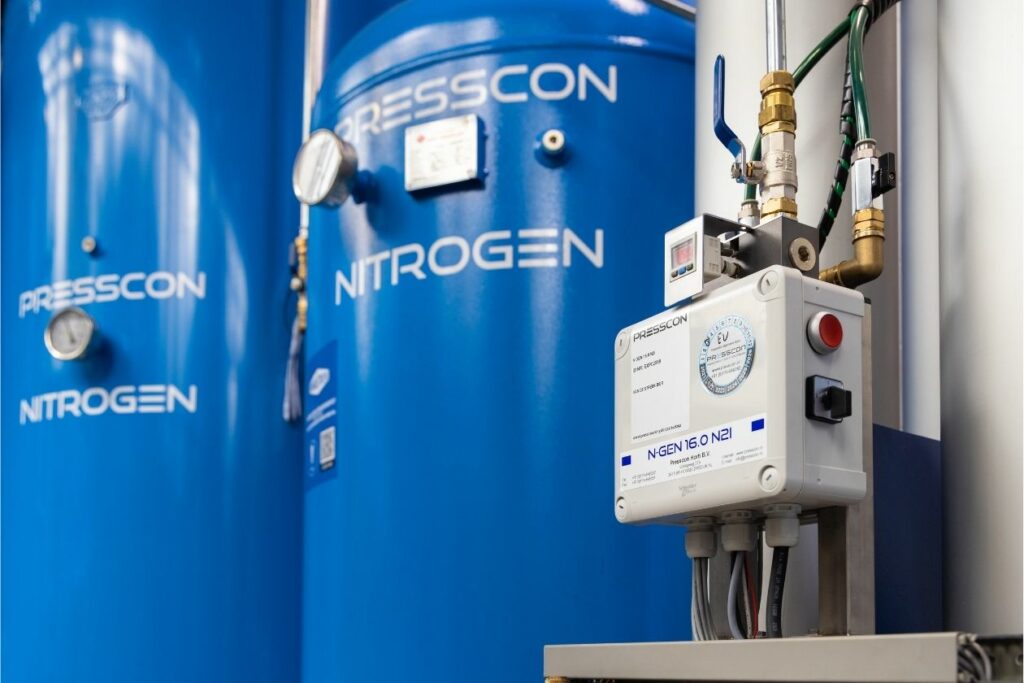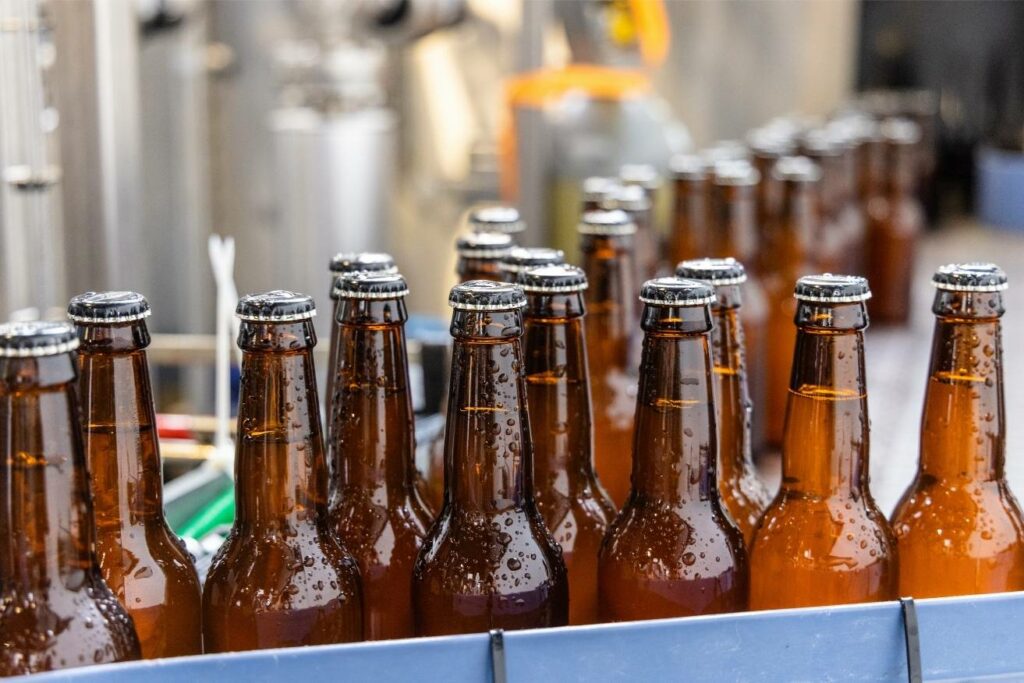Food processing with nitrogen
Innovative nitrogen solutions for food processing
Using nitrogen in food packaging is a proven way to extend shelf life, preserve freshness, and reduce food wast, all without compromising safety or quality. As part of Modified Atmosphere Packaging (MAP), nitrogen plays a vital role across the global food system, supporting both food producers and consumers.
Nitrogen in food packaging
Fresh food is sensitive to time, temperature, and exposure to air. Oxygen accelerates spoilage, alters colour and taste, and causes unnecessary waste. Packing foods with nitrogen has been proven to be an effective method of prolonging their shelf lives. With Modified Atmosphere Packaging (MAP) using nitrogen, you can extend shelf life and preserve the freshness of vegetables, fruit, meat, and ready meals, all without compromising quality.
Why use nitrogen gas in food packaging?
Air contains approximately 78% nitrogen, 21% oxygen and a variable amount of moisture. When exposed to air, foods such as potato chips absorb moisture and go stale and soggy quickly. Atmospheric oxygen also reacts with the unsaturated fatty acids present in foods, resulting in rancid off-flavours. Consequently, it is always a challenge faced by food manufacturers in preserving the desirable quality and prolonging the shelf life of food products.
The use of packaging gas is an effective solution. A packaging gas is a gas that is introduced into a package before, during or after filling with food to protect the food from oxidation or spoilage. Examples include nitrogen, carbon dioxide and nitrous oxide. Nitrogen has a long history of use as a packaging gas in various foods including snacks, breakfast cereals, candies, bakery products, dried fruits and vegetables, and processed meat products.

What is nitrogen packaging?
Nitrogen is an inert gas, meaning it doesn’t react with food components. When used in food packaging, nitrogen displaces oxygen, which slows down oxidation, inhibits microbial growth, and helps maintain texture, flavour, and colour. This makes nitrogen an essential solution in food packaging to:
- Slow down oxidation and spoilage
- Inhibit bacterial growth
- Preserve taste, texture, and colour
- Reduce the need for chemical preservatives
- Prevent package collapse or bulging
How Modified Atmosphere Packaging (MAP) works
MAP, or Modified Atmosphere Packaging, is a technique used in the food industry to extend the shelf life of fresh produce and perishable food products. MAP packaging is specifically designed to preserve food quality, which not only reduces waste but also ensures better freshness for consumers. In MAP packaging, by means of a nitrogen generator, nitrogen is introduced into the package that is matched to the type of food product. The amount of nitrogen in a MAP package depends on the characteristics of the packaged product and the desired shelf life. Modified Atmosphere Packaging (MAP) replaces oxygen with nitrogen gas or carbon dioxide to reduce oxygen deprivation, preventing oxidation, moisture loss, and microbial spoilage, thereby extending shelf life and maintaining food quality.
Map's strengths for the food processing industry
- Extension of shelf life of food
- Preserve colour and structure of foods
- Protection of power supply
- Less to no additional chemical additives required
Gases used in MAP
| Gas | Function in food packaging | Example use case |
|---|---|---|
| Nitrogen (N₂) | Inert gas that replaces oxygen to prevent oxidation, spoilage, and microbial growth | Snack foods, fresh produce, coffee |
| Oxygen (O₂) | Maintains color and texture in some products; supports red color in fresh meat | Red meat, some dairy products |
| Carbon dioxide (CO₂) | Inhibits microbial growth (bacteriostatic); often used in combination with nitrogen and oxygen | Meat, cheese, combination MAP mixes |
By choosing the right gas mixture, a company can ensure that a product does not dry out, does not oxidize, and retains its flavor, color and texture. MAP packaging is mainly used for products such as meat, cheese, fish, vegetables, and fruits, which are prone to spoilage.
Nitrogen packaging systems
Nitrogen packaging is any packaging system where nitrogen is used to create a protective atmosphere inside sealed food containers. A nitrogen packaging system is the complete setup designed to enable consistent and controlled nitrogen use during food packaging. These systems are integrated into production lines to ensure reliability and efficiency. A full nitrogen packaging system includes a nitrogen generator, packaging machine, gas injectors, high-barrier films, and precision sealers.
What does a nitrogen packaging system consist of?
Nitrogen packing machine
In a nitrogen packaging machine, nitrogen is used to automatically inject nitrogen gas into food production, coffee packaging and ready meals to guarantee freshness and prevent spoilage.
Nitrogen food storage
Nitrogen food storage involves displacing oxygen in the storage environment with pure nitrogen gas (N₂). Since nitrogen is inert (non-reactive), it does not interact with the food, but it slows down degradation by:
- Preventing oxidation (which causes rancidity, colour change, and nutrient loss)
- Reducing the growth of aerobic bacteria, mould, and yeast
- Maintaining the food’s texture, taste, and appearance
Nitrogen flushing technique
Nitrogen flushing is a packaging technique used to extend the shelf life of food products by replacing the oxygen inside a package with pure nitrogen gas (N₂). This process helps preserve freshness, prevent spoilage, and maintain the overall quality of the product, without the need of chemical additives. Nitrogen flushing is a well-established method that complies with international food safety regulations. It is used by food producers around the world. Nitrogen flushing is part of a Modified Atmosphere Packaging (MAP) system.
On-site nitrogen generation for the food industry
On-site nitrogen generation is rapidly becoming the preferred choice for food producers looking to reduce costs, eliminate logistical hassle, and ensure a stable nitrogen supply. Systems like N-Gen generator offer modular, energy-efficient technology that delivers high-purity nitrogen (up to 99.9999%) on demand, without reliance on external deliveries or volatile gas prices. By removing the need to order, store and manage gas cylinders, and by cutting compressed-air usage by up to 50%, food companies benefit from lower and more predictable operational costs. The return on investment is often achieved within 12–18 months, making it an attractive, scalable and sustainable solution for modern food packaging environments.

The main uses of nitrogen in the food industry
Nitrogen ensures proper storage of food liquids by reducing or eliminating the presence of air (and thus oxygen), inhibits bacterial growth, reduces the damaging effects of moisture, and protects the conduction system from external contamination. Because of all these properties, nitrogen has extensive use in the food industry to preserve foods from losing some of their organoleptic characteristics.
Here are the main uses:
- Improving the shelf-life of packaged foods by preventing spoilage from oxidation, mould growth, moisture leakage and infestation
- Rapid freezing (cryogenic freezing and IQF) of foods.
- For traditional transport of ingredients and the inerting of food storage tanks
- Packaging in a protective atmosphere
Top 7 uses of nitrogen in food
- Snack foods (Chips, Nuts, Popcorn)
Nitrogen prevents staleness and oxidation in crispy products. It also acts as a cushion inside airtight packaging, protecting snacks from getting crushed during transport. - Meat and poultry (Processed and fresh)
Modified Atmosphere Packaging (MAP) with nitrogen helps preserve meat’s color, texture, and freshness by slowing down bacterial growth and oxidation. - Fresh produce (Salads, fruit, vegetable sticks)
Pre-cut vegetables and salads stay fresh longer when packaged in a nitrogen-rich atmosphere that reduces moisture loss and microbial spoilage. - Cheese and dairy products
Nitrogen inhibits mold growth and maintains the texture and flavor of cheese and other dairy products without the need for chemical preservatives. - Bakery and dried foods
Bread, pastries, and dried goods benefit from nitrogen flushing to prevent moisture uptake, rancidity, and insect infestation. - Beverages (wine, beer, carbonated drinks)
Nitrogen is used to displace oxygen in bottled beverages to preserve flavor and prevent spoilage, especially in sensitive drinks like wine and cold brew coffee. - Ready meals and long-shelf-life products
Frozen meals, emergency rations, and shelf-stable supplies use nitrogen to ensure freshness and product integrity over long storage periods.
Custom solutions from Presscon
Presscon supplies tailor-made installations, fully customized to your needs and the design of your company. With over 20 years of experience and various patents to our name, we are the preferred collaborator for the food processing industry.
We are happy to advise you on the possibilities to guarantee the quality of the food in your company through Modified Atmosphere Packaging (MAP).

OUR NITROGEN GENERATORS
PRESSCON
- Modular design
- Low energy consumption
- Long lifespan
- Multifunctional use
Why is nitrogen essentail for food packaging?
By displacing oxygen, this inert gas helps extend shelf life, maintain taste and texture, and reduce the need for chemical preservatives. Through techniques like Modified Atmosphere Packaging (MAP), nitrogen is widely used in snacks, fresh produce, meat, dairy, beverages, and ready meals. Food manufacturers benefit from a reliable, safe, and scalable solution that meets international food safety standards. As consumer demand for freshness and sustainability continues to grow, nitrogen remains a key innovation in protecting both product integrity and brand quality.
Presscon specializes in the design, construction, and maintenance innovative solutions using compressed air and nitrogen. Want to know more? Contact Presscon.
Frequently asked questions
Is nitrogen safe for food use?
Yes. Food-grade nitrogen has been rigorously evaluated by international authorities such as the FAO/WHO Joint Expert Committee on Food Additives (JECFA). It is tasteless, odourless, and completely safe when used according to Good Manufacturing Practice (GMP).
How does nitrogen gas transform our global food system?
Nitrogen is a foundational element in both the nitrogen cycle and modern food production. Even though pure nitrogen (gas) makes up 78% of the atmosphere, its form and application, especially in food packaging, have far‑reaching consequences across the entire food system, including food processing, food waste, public health, and environmental impacts.
What is nitrogen flushing vs. vacuum packing?
Nitrogen flushing and vacuum packing are both packaging methods used to extend the shelf life of food products. Both methods aim to preserve freshness, but the choice depends on the type of product and desired shelf life. Nitrogen flushing is ideal for delicate, dry goods that need a cushioned atmosphere, while vacuum packing is better for dense, moist foods where full air removal is essential.
